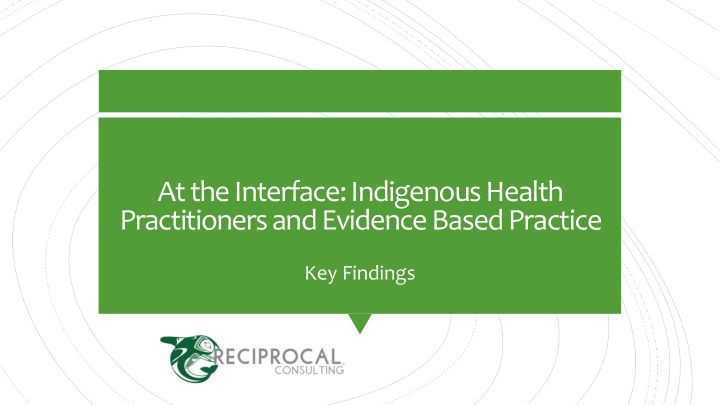



At the Interface: Indigenous Health Practitioners and Evidence Based Practice Key Findings
Hardest thing to overcome: we are meant to be doing the journey together equally…both are supposed to be valid. The feeling isn’t About the that [Indigenous knowledge] Project is equal, it’s that it’s tolerated. And they say, “Oh that’s nice but Western is the real medicine.” There is still a lot of attitude to get over.
Because both approaches offer benefit but not at the exclusion of the other and that each approach does not pervert the other. In other respects it is worth noting that Western approaches tend to exist in what is described culturally as mouse medicine. This approach focuses intently at the micro level of awareness whilst the Indigenous approach tends to be more focused on the macro level or eagle medicine approach. Seeing the whole vs silos. Evidence-Based Practice
As an Indigenous person, you cannot separate yourself from the knowledge. You cannot separate yourself from practice.. Access to Evidence and Gaps in Knowledge
Medicine and science are young fields of study and Indigenous knowledge is much more ancient Traditional knowledge systems and deal with the more difficult and Knowledge in intangible things, such as Health Care spiritual health and wellness. A lot of that, you have to look Practice at the individual lived experience as well as the Elders and knowledge keepers they’re working with.
Barriers to Blending Indigenous and Western Knowledge I still think they have to get over a lot of healthcare providers’ stereotypes about Indigenous people that are engrained in our society. Indigenous health in my family was seen as something unworthy, as bad, as witchcraft and that it shouldn’t be passed on, My own grandfather, he knew medicines, he thought it was negative and wanted to be a good Christian family, so he didn’t pass it on, and that was the mentality. All of our ceremonies were illegal, [and] lots of things had to be hidden.
Evidence is partly based in the privileging of non-Indigenous evidence. It’s an assumption that Western evidence is superior to Indigenous Barriers to Blending evidence, and Indigenous knowledge is second-class and Indigenous and second rate — second to their Western Knowledge actions, recommendations and interventions. Evidence is not a scientific fact; it is a privileged interaction between populations and healthcare workers. Evidence is not a thing, it’s a process .
Wise Practices to Blending Indigenous and Western Knowledge We have to be careful to not subordinate Indigenous knowledge to Western knowledge. We have to look at how we’re gathering evidence and whether it’s consistent with the underlying philosophies of the people you’re working with or the phenomena you’re working with.
Wise Practices to Blending Indigenous and Western Knowledge The folks I work with live a dual life of being Indigenous and living in a Western culture. Many discuss their own struggles with trying to navigate the middle ground between these worlds. Using aspects of both in therapy help folks navigate the process of building bridges between these worlds.
It’s really helpful to have those that understand that these practices can work alongside one another. To have support for that idea from leadership, so that you don’t feel like you’re isolated in doing this and advocating for this on your own. It requires more Discussion space and time as well. It means building relationships with traditional knowledge keepers, Elders, spiritual advisors, and making sure that they are supported and compensated and that requires support from leadership.
Recommend
More recommend